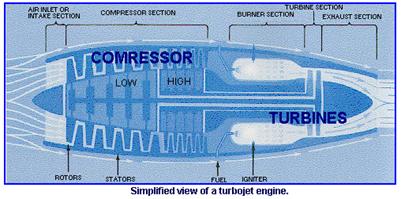Published on Jun 05, 2023
Aeroplane Propulsion System
A heavier than air flying machine, supported by aerofoils, designed to obtain, when driven through the air at an angle inclined to the direction of motion, a reaction from the air approximately at right angle to their surfaces is known as aeroplane. The various forces which acts on the aeroplane when it travels through the air are lift force, drag force, thrust force and its own weight. For steady condition the weight should be balanced by the lift and drag by thrust. The lift is obtained due to the special shape of wings and thrust is obtained by propulsion systems.
INTRODUCTION
What is an air craft?
"All man made contrivances which fly, that is to say which are kept in the air by forces produced by the air are called aircraft".
Eg: balloons, kites, aeroplanes etc.
There are two kinds of air crafts, those which are lighter than air and those which heavier than air. The lighter than means their weight by volume is less than that of air. Heavier than means the weight by volume is heavier than that of air. The former includes balloons, airships etc. and the later comprises kites and aero planes.
AEROPLANE BASICS
Definition
"A heavier than air flying machine supported by airfoils , designed to obtain, when driven through the air at an angle inclined to the direction of motion, a reaction from the air approximately at right angles to their surfaces".
Four forces on an aeroplane
Weight
Weight is a force that is always directed toward the center of the earth. The magnitude of this force depends on the mass of all of the parts of the airplane itself, plus the amount of fuel, plus any payload on board (people, baggage, freight, ...).The weight is distributed throughout the airplane. But we can often think of it as collected and acting through a single point called the center of gravity. In flight, the airplane rotates about the center of gravity, but the direction of the weight force always remains toward the center of the earth. During a flight, the airplane's weight constantly changes as the aircraft consumes fuel.
PROPELLER PROPULSION
A piston engine requires a propeller to convert the power output of the engine in to thrust. The power is developed by the piston engine, and is transmitted to the propeller, via a shaft, as engine torque or turning effect. This is used to rotate the propeller, which converts most of the turning effect in to a pull or push force, called thrust. The propeller does this by generating forces which result from its motion through air.
The propeller pulls the aeroplane through the air by generating a basically ‘lift’force which we call thrust.
The propeller blade is so fitted that its curved face is always at the front side of the plane. Thus the propeller blade causes the air to flow so that the static pressure ahead of the blade is less than that behind the blade. The result is a forward thrust force on the propeller blade which pulls the aeroplane along.

Motion of the propeller
When the aeroplane is moving forward, the propeller will have two different motions.
1. Forward motion
2. Rotational motion